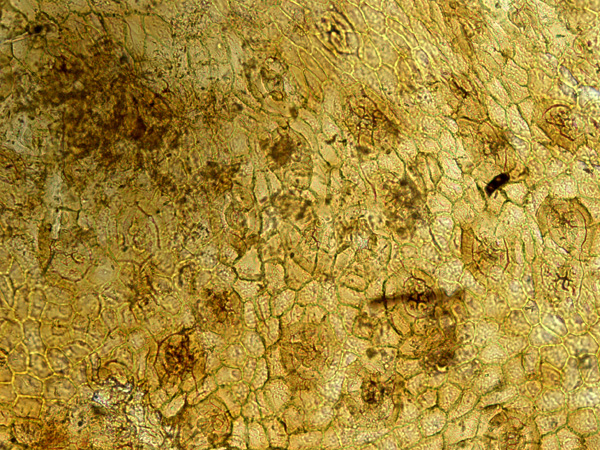History of terrestrial ecosystems recorded in fossilized dinosaur dung – publication in Nature
Dinosaurs appeared on Earth in the middle Triassic. Their evolution, which accelerated rapidly at the beginning of the Jurassic and led to the domination of these vertebrates on land for over a hundred million years, and then the mass extinction at the end of the Cretaceous, has been the subject of scientific research since at least the 19th century. Despite intensive research efforts, many issues remain in the realm of speculation. An example is those concerning the early stages of dinosaur diversification and expansion.
Nature has just published an article that sheds some light on the beginnings of dinosaur evolution. The authors, including Dr Maria Barbacka and Dr Jadwiga Ziaja from our Institute, examined a large number of different types of fossils, mainly coprolites – fossilized faeces – from the Late Triassic and Early Jurassic of Poland (the Holy Cross Mountains were a particularly rich source of which). Modern tools, such as propagation phase-contrast synchrotron microtomography (European Synchrotron Radiation Facility, Grenoble, France), and interdisciplinary research methods developed by a Polish-Swedish-Norwegian team of scientists allowed for non-invasive analysis of most of the material, i.e. without unnecessary destruction of the specimens. Only small fragments of coprolites were dissolved chemically to obtain undigested fragments of plants or animals for detailed analysis.
Based on the appearance of the coprolites and their contents, as well as numerous dinosaur footprints, the scientists determined the type of animal: herbivorous or predatory. Then, by comparing the material analyzed with similar traces and skeletal remains from other sites worldwide, they determined the animal's taxonomic position, body structure and size, and, using the latest knowledge, also feeding habits. As a result, it was possible to reconstruct not only the composition of the dinosaur communities but also the trophic relationships and the environment in which these animals functioned. Our specialists in fossil flora were responsible for analyzing the plant remains, providing key information on the base of the trophic pyramid and habitat conditions at the time.
The fossil material studied shows an increase in the presence and species diversity of dinosaurs in the area of present-day Poland. This was most likely caused by environmental changes. In the Late Triassic, in areas with a significant share of the sea (land with a long coastline), with vegetation dominated by conifers, with a small admixture of ferns and horsetails, omnivorous precursors of dinosaurs appeared (replacing reptiles that had previously lived there), followed by insectivorous and piscivorous theropods and small omnivorous dinosaurs. Late Triassic topographic changes – the creation of a well-watered area by meandering rivers – and the gradual increase in land area (at the expense of the sea) at the turn of the Triassic and Jurassic and in the Early Jurassic caused coniferous forests to give way to richer vegetation. The diversity of plants (horsetails, ferns, seed ferns, cycads, conifers) occupying different ecological niches became the basis for the expansion of herbivores and the replacement of pseudosuchians (crocodile-like reptiles) and therapsids (mammal-like reptiles), which were not very picky when it came to diet. The abundance of food favoured the appearance of giant forms such as sauropodomorphs and early ornithischians. The dinosaurs from the Holy Cross Mountains had the most large-leaved gymnosperms in their diet, such as seed ferns and cycads; conifers were eaten in smaller quantities. The diet shows that these animals chose high-energy food and that they had it in abundance. In response to the emergence of a new pool of herbivores (potential prey), predatory forms developed, theropods, which evolved quickly and reached enormous sizes.
Original article:
Qvarnström M., Vikberg Wernström J., Wawrzyniak Z., Barbacka M., Pacyna G., Górecki A., Ziaja J., Jarzynka A., Owocki K., Sulej T., Marynowski L., Pieńkowski G., Ahlberg P.E., Niedźwiedzki G. 2024. Digestive contents and food webs record the advent of dinosaur supremacy. Nature 636: 397–403. DOI
More information about plant remains found in coprolites from the Early Jurassic of Sołtykowo (Poland) can be found in our other text. We encourage you to read it!

Batrachotomus, a relative of modern crocodiles, in a Triassic environment – State Museum of Natural History, Stuttgart.
Photo: pxhere.com.

Komlopteris distinctiva, a new species of an extinct group of seed ferns described from the coprolites of a herbivorous and predatory dinosaur – a fragment of the apical part of the leaf with visible venation.
Photo: Maria Barbacka.

Komlopteris distinctiva – a fragment of leaf cuticle with stomata.
Photo: Maria Barbacka.

A fragment of Pachypteris papillosa leaf with three almost complete leaflets preserved, isolated from a coprolite of a predatory dinosaur. This species also occurred in coprolites of a herbivorous dinosaur.
Photo: Maria Barbacka.

Pachypteris papillosa – cuticle with visible stomata.
Photo: Maria Barbacka.

Fragment of the leaf cuticle of Pterophyllum sp. from the extinct bennettitalean group.
Photo: Maria Barbacka.

The specimen from the previous photo enlarged; cuticles are visible on both sides of the leaf, the upper one without stomata and the lower one with stomata.
Photo: Maria Barbacka.

Aciphyllum triangulatum, a new genus and species described from a coprolite of a predatory dinosaur – a unique fragment of a conifer needle, probably an extinct ancestor of the pine. Three sides of the triangular needle are visible in cross-section.
Photo: Maria Barbacka.

The same needle, with visible stomata, photographed under a fluorescence microscope.
Photo: Maria Barbacka.

A small fragment of a leafy branch of a coniferous tree Brachyphyllum sp. (similar to today's thuja) from a coprolite of a predatory dinosaur. The species also occurs in coprolites of herbivorous dinosaurs.
Photo: Maria Barbacka.

Cuticle of Brachyphyllum sp. with visible stomata.
Photo: Maria Barbacka.

Unidentified wood fragment (twig) from a predatory dinosaur coprolite, SEM photo.
Photo: Károly Bóka.

Uncovering a rock with numerous visible dinosaur traces in the Sołtyków reserve, Poland.
Photo: Maria Barbacka.

Reserve in Sołtyków (Poland) – site of dinosaur traces and coprolites.
Photo: Maria Barbacka.





